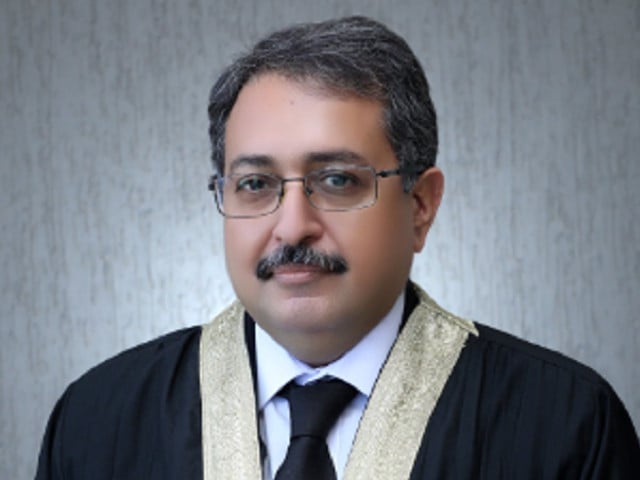Three judges of the Islamabad High Court (IHC) have raised serious concerns regarding Chief Justice Aamer Farooq’s actions and accused him of attempting to suppress the majority judgment in the Tyrian case through administrative measures.
On May 22, the IHC dismissed a petition seeking the disqualification of former Prime Minister Imran Khan for allegedly concealing his daughter, Tyrian White. A three-member bench consisting of Justices Tariq Mehmood Jahangiri, Arbab Mohammad Tahir, and Saman Rafat Imtiaz heard the petition after nearly a year’s delay. The court ruled that a previously constituted three-judge bench had already dismissed the petition.
“We find the reconstitution of this bench to be without lawful authority. Such reconstitution after all members have delivered their judgments is unprecedented. We cannot reconsider an already decided petition. The earlier bench, comprised of three learned judges, with the opinion/judgment of Mr. Justice Mohsin Akhtar Kayani, J., supported by one of us (Mr. Justice Arbab Muhammad Tahir, J.), dismissing the petition as not maintainable, holds majority support.
“The majority opinion was unsealed in open court and will be released to the parties. This shall stand, subject to any appeal order,” the detailed judgment issued by three members of the IHC in the Tyrian case states.
Justice Arbab Tahir, authoring the 14-page judgment, noted, “Once a matter has been heard, arguments concluded, and the case reserved for judgment, the chief justice loses the authority to transfer the case to another bench or reconstitute/dissolve such a bench.”
“Such actions are viewed as administrative manipulation to influence the outcome of judicial proceedings.”
“In essence, once a bench is constituted, the chief justice lacks the authority to reconstitute it unless requested by the bench through a judicial order. The matter becomes particularly serious when the chief justice is a member of the bench himself.
“He is aware of the potential outcome of a judicial matter. It becomes more significant when the chief justice drafts a judgment and circulates it to bench members, who then express disagreement with the chief justice’s opinion, provide their own judgments, and communicate these to him.”
The judgment noted that the chief justice observed in his notes that after receiving his draft judgment, two members of the larger bench independently issued signed judgments without consulting him. Disagreement with the chief justice’s opinion and expression of independent views do not constitute misconduct or breach of established practice. Judicial practices evolve to safeguard justice, but these practices must not stifle a judge’s independence to form opinions according to the law and conscience.
The chief justice had formed the opinion that the petition was maintainable, while the other two members disagreed. The reconstitution of the larger bench by the chief justice, following receipt of separate judgments from two bench colleagues, prima facie qualifies as an attempt to stifle the independent judgment of the bench members. While the chief justice was entitled to express his judicial opinion, he could not obstruct the majority judgment through administrative means by reconstituting the bench.
“In this instance, the chief justice, author of the minority view, could not use administrative authority to suppress the majority judgment with a single administrative decision to reconstitute the bench.
“The majority opinion, supported by two of three learned judges, including the chief justice, constitutes the majority. This judicial opinion/judgment of the majority stands and cannot be annulled by an office note or administrative press release from the chief justice. Court judgments are based on evidence and legal reasoning, not speculative characters. Such speculation cannot manipulate the outcome of judicial matters through bench dissolution/reconstitution.”
The court also pointed out that cases with political implications pending before courts often attract significant debate in mainstream and social media. We cannot allow our judicial findings to be manipulated by party speculations or their agents, ignoring legal mandates.
“If this court succumbs to such tactics, it will allow malevolent intentions to interfere with judicial outcomes and undermine the court’s role as an independent arbiter of disputes.
“Review of the records shows that before the bench was reconstituted, a member of the earlier bench, Mr. Justice Mohsin Akhtar Kayani, Senior Puisne Judge, wrote two office notes (one to the Secretary to the learned Chief Justice and the other to the Registrar of this court) requesting a cause list issuance to reassemble the bench for the judgment’s pronouncement.
“It appears the registrar did not comply with these directions without a credible explanation.”
The judgment expressed bewilderment that despite explicit requests from the author of the majority judgment, the office failed to issue a cause list. Thus, the judgment authored by Mr. Justice Mohsin Akhtar Kayani, learned senior puisne judge, supported by Mr. Justice Arbab Muhammad Tahir, was uploaded on the Islamabad High Court’s official website as per their instructions, but it was removed without their prior approval or consent.
The judgment further explained that the chief justice has the power to “constitute” benches for matters under consideration. Once this power is exercised, the chief justice cannot subsequently alter or modify the bench’s composition unless a judicial order refers the matter back to him.
“There is a distinction between ‘constitution,’ ‘reconstitution,’ and ‘dissolution’ of benches, closely linked to the nature and stage of proceedings. If a bench member is unavailable or recuses from hearing a matter or refers it back to the chief justice for reconstitution, the chief justice then has the authority to issue appropriate orders.
“Due to the registrar’s refusal to issue a cause list despite explicit requests under Order XX of the Civil Procedure Code by the learned senior puisne judge, the two bench members were compelled to release their judgment on the official website.
“The release of the majority judgment without a cause list issuance was not a ‘deficiency’ or ‘lapse’ but a ‘defiance’ by the court’s registrar.”




